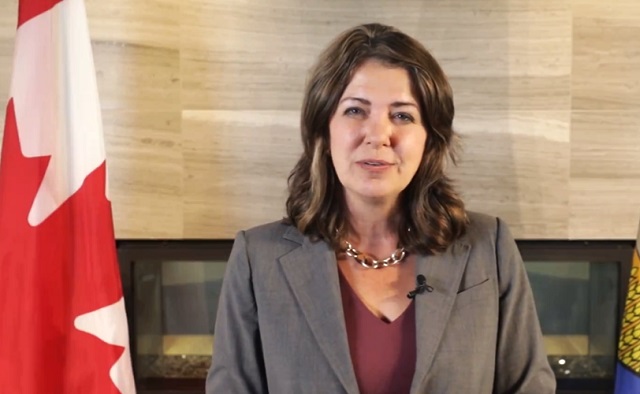Health
Time for an intervention – an urgent call to end “gender-affirming” treatments for children

From the Macdonald Laurier Institute
By J. Edward Les
Despite the Cass Review’s alarming findings, trans activists and their enablers in the medical professions continue to push kids into having dangerous, life-altering surgeries and hormone-blocking treatments. It needs to stop.
If nothing else, the scathing final report of the Cass Review released this week (but commissioned four years ago to investigate the disturbing practices of the UK’s Gender Identity Service), is a reminder that doctors historically are guilty of many sins.
Take the Tuskegee syphilis study, one of the greatest stains on the medical profession, in which impoverished syphilis-infected black men were knowingly deprived of therapy so that researchers could study the natural history of untreated disease.
Or consider the repugnant New Zealand cervical cancer study in the 1960s and 1970s, which left women untreated for years so that researchers could learn how cervical cancer progressed. Or the Swedish efforts to solidify the link between sugar and dental decay by feeding copious amounts of sweets to the mentally handicapped.
The doctors behind such scandals undoubtedly felt they were advancing scientific inquiry in pursuit of the greater good; but they clearly stampeded far beyond the boundaries of ethical medical practice.
More common by far, though, are medical “sins” committed unknowingly, such as when doctors prescribe toxic treatments to patients in the mistaken belief that they are beneficial. When physicians in Europe and Canada latched onto thalidomide in the late 1950s and early 1960s, for instance, they thought it was a wonder drug for morning sickness. Only the fine work of Dr. Francis Kelsey, an astute pharmacist at the FDA, prevented the ensuing birth-defects tragedy from being visited upon American women and children.
And when Oxycontin hit the medical marketplace in the 1990s, physicians embraced it as a marvellous — and supposedly non-addictive — solution to their patients’ pain. But the drug was simply another synthetic derivative of opium, and every bit as addictive; its use triggered a massive opioid overdose crisis — still ongoing today — that has killed hundreds of thousands and ruined the lives of countless individuals and their families.
Physicians in the latter instances weren’t driven by malevolence; but rather by a deep-seated desire to help patients. That wish, compounded by extreme busy-ness, repeatedly seduces doctors into unwarranted faith in untested therapies.
And no discipline in medicine, arguably, is more frequently led astray by the siren song of shiny new things than the field of psychiatry. Which is understandable, perhaps, given the nature of psychiatric practice. Categorizations of mental disorders — and the methods used to treat them — are based almost entirely on consensus opinion, rather than on direct measurement. Contrast that with other domains of medical practice: appendicitis is diagnosed by imaging the infected organ, and then cured by surgically removing the inflamed tissue; diabetes is detected by measuring elevated blood sugar, and then corrected by the administration of insulin; elevated blood pressure is calibrated in millimetres of mercury, and then effectively reduced with antihypertensives; and so on.
But mental disturbances remain largely the stuff of conjecture — learned conjecture, mind you, but conjecture, nonetheless. The Diagnostic and Statistical Manual of Mental Disorders, the “bible” of mental health professionals, is the collective effort of groups of tall foreheads gathered around conference tables opining on the various perturbations of the human mind. Imprecise definitions abound, with heaps of overlap between conditions.
The current version (DSM-5) describes schizophrenia, for example, as occurring on a spectrum of “abnormalities in one or more of the following five domains: delusions, hallucinations, disorganized thinking (speech), grossly disorganized or abnormal motor behavior (including catatonia), and negative symptoms.” Each of these five domains is open to professional interpretation; and what’s more, the schizophrenia spectrum is further subdivided into ten sub-categories.
That theme runs through the entire manual – and imprecise definitions lead on to imprecise solutions. Given the blurred indications for starting, balancing, and stopping medications, it’s no accident that many mentally unwell patients languish on ever-changing cocktails of mind-altering drugs.
None of which is to downplay the enormous importance of psychiatry, which does much to address human suffering amidst unimaginable complexity; its practitioners are among the brightest and most capable members of the medical profession. But by its very nature the discipline is submerged in — and handicapped by — uncertainty. It’s unsurprising, then, that mental health professionals desperate for effective treatments are susceptible to being misled.
The dark history of frontal lobotomies, seized upon by psychiatrists as a miracle cure but long relegated to the trash heap of medical barbarism, is well known. The procedure (which garnered its inventor the Nobel Prize in Medicine) basically consisted of driving an ice pick through patients’ eye sockets to destroy their frontal lobes; thousands of patients were permanently maimed before saner heads prevailed and the practice was halted. Many of its victims were gay men: “conversion therapy” with a literal, brain-altering “punch.”
Similarly, the fabricated “recovered memories of sexual abuse” saga of the 1980s and early 1990s suckered mental health practitioners into believing it was legitimate. Hundreds of professional careers were built on the “therapy” before it was all exposed as a fraud, leaving many lives ruined, families torn asunder, and scores of innocent men imprisoned or dead from suicide. In a 2005 review, Harvard psychology professor Richard McNally pegged the recovered memory movement as “the worst catastrophe to befall the mental health field since the lobotomy era.”
Until now, that is. That scandal pales in comparison to the “gender transition/gender affirming care” craze that has befogged the medical profession in recent years.
Without a shred of supporting scientific evidence, many doctors — led by psychiatrists, but aided and abetted by endocrinologists, surgeons, pediatricians, and family doctors — have bought into the mystical notion of gender fluidity. What was previously recognized as “gender identity disorder” was rebranded as gender “dysphoria” and recast as part of the normal spectrum of human experience, the basic truth of binary mammalian biology simply discarded in favour of the fiction that it’s possible to convert from one sex to another.
Much suffering has ensued. The enabling of biological males’ invasion of women’s spaces, rape shelters, prisons, and sports is bad enough. But what is being done to children is the stuff of horror movies: doctors are using medications to block physiological puberty as prologue to cross-gender hormones, genital-revising surgery, and a lifetime of infertility and medical misery — and labelling the entire sordid mess as gender-affirming care.
The malignant fad began innocently enough, with a Dutch effort in the late 1980s and early 1990s to improve the lot of transgendered adults troubled by the disconnect between their physical bodies and their gender identity. Those clinicians’ motivations were defensible, perhaps; but their research was riddled with ethical lapses and methodological errors and has since been thoroughly discredited. Yet their methods “escaped the lab”, with the international medical community adopting them as a template for managing gender-confused children, and the World Professional Association for Transgender Health (WPATH) enshrining them as “standard of care.” Then, as American social psychologist Jonathan Haidt is the latest to observe, the rise of social media torqued the trend into a craze by convincing hordes of adolescents they were “trans.” Which is how we ended up where we are today, with science replaced by rabid ideology — and with condemnation heaped upon anyone who dares to challenge it.
An explanation sometimes offered for the massive spike in gender-confused kids seeking “affirmation” in the past fifteen years is that today it’s “safe” for kids to express themselves, as if this phenomenon always existed but that — as with homosexuality — it was “closeted” due to stigma. Yet are we really expected to believe that the giants of empirical research into childhood development —brilliant minds like Jean Piaget, Eric Erikson, Lev Vygotsky, and Lawrence Kohlberg — somehow missed entirely the trait of mutable “gender identity” amongst all the other childhood traits they were studying? That’s nonsense, of course. They didn’t miss it — because it isn’t real.
The fog is beginning to dissipate, thankfully. Multiple jurisdictions around the world, including the UK, Sweden, Norway, Finland, and France have begun to realize the grave harm that has been done, and are pulling back from — or halting altogether — the practice of blocking puberty. And the final Cass Report goes even further, taking square aim at the dangerous practice of social transitioning and concluding that it’s “not a neutral act” but instead presents risk of grave psychological harm.
All of which places Canada in a rather awkward position. Because in December of 2021 parliamentarians gave unanimous consent to Bill C-4, which bans conversion therapy, including “any practice, service or treatment designed to change a person’s gender identity.” It’s since been a crime in Canada, punishable by up to five years in prison, to try to help your child feel comfortable with his or her sex.
As far as I know, no one has been charged, let alone imprisoned, since the bill was passed into law. But it certainly has cast a chill on the willingness of providers to deliver appropriate counselling to gender-confused children: few dare to risk it.
A conversion therapy ban had been in the works for years, triggered by concerns about disturbing and harmful practices targeting gay children. But by the time the bill was presented in its final form to Parliament for a vote it had been hijacked by trans activists, with its content perverted to the degree that there is more language in the legislation speaking to gender identity than to homosexuality.
To be clear, likening homosexuality to pediatric “gender fluidity” is a category error, akin to comparing apples to elephants. The one is an innate sexual orientation, the acceptance of which requires simply leaving people be to live their lives and love whomever they wish; the other is wholly imaginary, the acceptance of which mandates irreversible medical (and often surgical) intervention and the transformation of children into lifelong (and usually infertile) medical patients.
And the real “elephant” in the room is that in a troubling number of cases pediatric trans care is conversion therapy for gay children because for some people, it’s more acceptable to be trans than it is to be gay.
Bill C-4 received unanimous endorsement from all parliamentarians, including from Pierre Poilievre, now the leader of the Conservative Party. No debate. No analysis. Just high-fives all around for the television cameras.
It’s possible that many of the opposition MPs hastening to support the ban did so for fear of being painted as bigots. Yet the primary responsibility of an opposition party in any healthy democracy is to oppose, even when it’s unpopular. In 2015, when NDP Opposition leader Tom Mulcair faced withering criticism for resisting anti-terror legislation tabled by Stephen Harper’s Conservative government, he cited John Diefenbaker’s comments on the role of political opposition:
“The reading of history proves that freedom always dies when criticism ends… The Opposition finds fault; it suggests amendments; it asks questions and elicits information; it arouses, educates, and moulds public opinion by voice and vote… It must scrutinize every action of the government and, in doing so, prevents the shortcuts through democratic procedure that governments like to make.”
In the case of Bill C-4 the Conservatives did none of that. And by abdicating their responsibility they helped drive a metaphorical ice pick into the futures of scores of innocent children, destroying forever their prospects for normal, healthy lives.
We’re long overdue for a “conversion”: a conversion back to the light of reason, a conversion back to evidence-based care of children.
In 1962, when the harms of thalidomide became known, it was withdrawn from the Canadian market. In 2024, now that the serious harms of “gender-affirming care” have been exposed, it remains an open question as to when Canada’s doctors and politicians will finally take the difficult step of admitting that they got it wrong and put a stop to the practice.
Dr. Edward Les is a pediatrician in Calgary who writes on politics, social issues, and other matters.
Red Deer
2024 Hospital Lottery presents major prizes

Officials from the Red Deer Regional Health Foundation have presented the top prize for the 2024 Red Deer Hospital Lottery.
The Grand Prize Dream Home package is valued at $1,072,624, including furnishings by Urban Barn. The key was presented to the winner, Maxine Rumohr of Sylvan Lake.
When informed that she was the grand prize winner, Rumohr said winning the home is a “dream come true.”
“This is a nice dream that I hope I don’t wake up from,” said Rumohr when she heard the news.
The bungalow by Sorento Custom Homes features 2,796 sq ft of finished living space and has four bedrooms, two and a half baths, and a large, covered deck with vaulted ceilings. Among its features are a large primary suite with ensuite and soaking tub, a basement entertainment area, a walk-in butler’s pantry, main floor laundry, and a stone clad gas
fireplace.
Manon Therriault, Foundation CEO, expressed appreciation at the prize presentation. “We are incredibly grateful to the hardworking team at Sorento Custom Homes for bringing us a truly breathtaking Dream Home again this year,” Therriault said, speaking of the Red Deer Hospital Lottery’s biggest supporter. “Enormous thanks as well to our dedicated volunteers. All of Central Alberta benefits from the dedication of this tireless group of individuals who give so generously of their time each year.”
This year’s proceeds from the Hospital Lottery and Mega Bucks 50 will provide funding for critically needed equipment for several units at Red Deer Hospital.

Other prize winners present included Carolyn Pelerine of Cochrane, Alberta, who walked away with the $303,600 Mega Bucks 50 prize, as well as the winner of the Tree Hugger Tiny Home prize package valued at $163,798, Mary Vincent of Red Deer.

Red Deer Hospital Lottery 2024 Winners Fact Sheet
– 26th year of the lottery
– Built by award-winning Sorento Custom Homes
– Valued at $1,072,624
– Located at 16 Emmett Crescent, Red Deer
– Bungalow with 2,796 square feet of finished living space, four bedrooms, 2.5 baths
– Winner: Maxine Rumohr of Sylvan Lake, Alberta
Tree Hugger Tiny Home Prize – (includes accessories from Urban Barn)
– Valued at $163,798
– Winner: Mary Vincent of Red Deer, Alberta
Mega Bucks 50
– 50/50 raffle – Total jackpot of $607,200
– Winner of $303,600: Carolyn Pelerine of Cochrane, Alberta
Early Bird Prize
– $20,000 CASH
– Drawn May 16, 2024 at 2:00 pm
– Winner: Frieda Doz of Edmonton, Alberta
Second Chance Early Bird Draw
– $10,000 CASH
– Drawn June 6, 2024 at 2:00 pm
– Winner: Wendy Howe of Castor, Alberta
Additional Prizes
– Total value of all prizes was over $1.29 million, including dream home and tiny home
– Prizes included
o Cuisinart air fryer and Barista coffee maker (6), GoPro HERO 12 (5), Asus Vivobook Flip 14” laptop (10), DJI Mini 2SE Drone Flycam (4), Dyson V8 cordless stick vacuum (10), Goal Zero Sherpa 100AC power bank (5)
Proceeds
– Proceeds from Red Deer Hospital Lottery and Mega Bucks 50 contribute to acquiring critically needed, state-of-the-art equipment in several units at the Red Deer Hospital. This year’s lottery will fund equipment like a phototherapy system to allow parents to hold and soothe their infant while undergoing phototherapy, a cardiology case cart to monitor cardiac rhythms during stress testing, and other equipment to provide excellent care for patients at the Red Deer Hospital.
About Red Deer Regional Health Foundation
The Red Deer Regional Health Foundation is a fundraising organization for Alberta Health Services Central Zone, with a mandate to raise and disburse funds for programs, services, and the purchase of medical equipment.
Alberta
Alberta Premier Danielle Smith promises bill protecting rights to refuse vaccines is coming

From LifeSiteNews
The plan is to introduce an amended Bill of Rights this fall that includes protections for individuals’ personal medical decisions.
Alberta Premier Danielle Smith has promised that the province’s Bill of Rights will be amended this fall so that there are protections added for people’s personal medical decisions that most likely will include one having the right to refuse a vaccine.
Smith’s promise to add protections for personal choice on vaccinations comes because of the COVID jab mandates put in place for a time in Alberta under former Premier Jason Kenney.
Speaking to Albertans at a recent town hall in Bonnyville, Smith said that the COVID crisis resulted in many people being discriminated against for their own medical decisions and that “it shouldn’t have happened.”
Smith, who leads the United Conservative Party (UCP), said that she believes “every person has to be able to do their own assessment, their own health assessment, to be able to make those decisions.”
The original plan by Smith was to add protections for one’s vaccine status directly Alberta Human Rights Act (AHRA). However, this plan was nixed after she was advised by Public Health Emergencies Governance Review Panel chair Preston Manning that this was not the right legislation for an additional protection.
Instead, Smith promised that a better “law” dealing directly with vaccine status will be forthcoming.
On Monday, Smith confirmed on X that an updated version of the Bill of Rights is coming.
“It’s time. Let’s get this done,” she wrote.
Last year, Smith, as reported by LifeSiteNews, promised to enshrine into “law” protections for people in her province who choose not to be vaccinated as well as strengthen gun rights and safeguard free speech by beefing up the provincial Bill of Rights.
“You have my commitment, no one’s going to be forced to be vaccinated,” Smith told Alberta blogger Shaun Newman.
On Smith’s first day on the job and only minutes after being sworn in, she said that during the COVID years the “unvaccinated” were the “most discriminated against” group of people in her lifetime.
She took over from Kenney as leader of the UCP on October 11, 2022, after winning the party leadership. The UCP then won a general election in May 2023. Kenney was ousted due to low approval ratings and for reneging on promises not to lock Alberta down during COVID.
Smith promptly fired the province’s top doctor, Deena Hinshaw, and the entire Alberta Health Services board of directors, all of whom oversaw the implementation of COVID mandates.
Under Kenney, thousands of nurses, doctors, and other healthcare and government workers lost their jobs for choosing to not get the jabs.
While Smith has not said much regarding the COVID shots since taking office, she has allowed her caucus members to have broad views when it comes to known safety issues related to the jabs.
UCP MLA Eric Bouchard hosted a sold-out event titled “An Injection of Truth” that featured prominent doctors and experts speaking out against COVID vaccines and mandates.
“Injection of Truth” included well-known speakers critical of COVID mandates and the shots, including Dr. Byram Bridle, Dr. William Makis, canceled doctor Mark Trozzi and pediatric neurologist Eric Payne.
The COVID shots were heavily promoted by the federal government and all provincial governments in Canada, with the Alberta government under Kenney being no exception.
The mRNA shots have been linked to a multitude of negative and often severe side effects in children.
-

 National1 day ago
National1 day agoLiberals offer no response as Conservative MP calls Trudeau a ‘liar’ for an hour straight
-

 COVID-191 day ago
COVID-191 day agoLeaked documents: German gov’t lied about shots preventing COVID, knew lockdowns did more harm than good
-

 Economy1 day ago
Economy1 day agoKamala Harris’ Energy Policy Catalog Is Full Of Whoppers
-

 International1 day ago
International1 day agoSwitzerland’s new portable suicide ‘pod’ set to claim its first life ‘soon’
-

 Business1 day ago
Business1 day agoFederal government seems committed to killing investment in Canada
-

 International20 hours ago
International20 hours agoHouse Passes Bipartisan Resolution Establishing Trump Assassination Attempt Task Force
-

 Crime9 hours ago
Crime9 hours agoEverything you need to know about the failed assassination attempt of Donald Trump
-

 Alberta1 day ago
Alberta1 day ago‘Fireworks’ As Defence Opens Case In Coutts Two Trial





